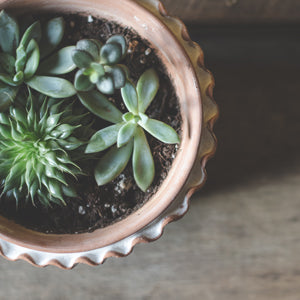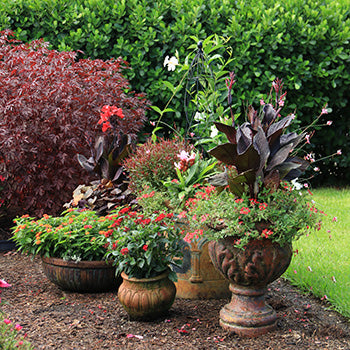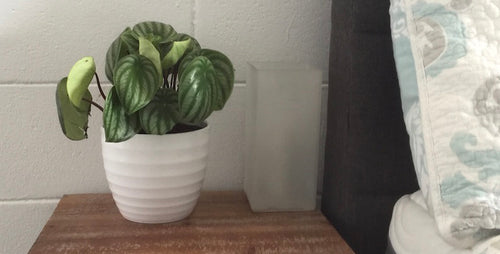For years, the popular Mythbusters TV show took pleasure in debunking myths and urban legends on a host of topics. But, although I was a big fan, I don’t recall them ever covering some of the more common gardening myths I hear about in my horticultural travels. So, to set the record straight, here are 10 common garden myths I’d like to retire once and for all.
Myth One: Gravel in the Bottom of the Pot Promotes Drainage
Probably the most common garden myth there is. However, water doesn’t easily travel from one medium to another so it’s not likely extra moisture in your soil will drip down into a gravel layer. Instead, it will stay in the soil, making it even wetter. You do need to be sure all pots have a drainage hole in the bottom, but don’t add gravel to the base. Just fill your pots with potting soil and your plants will be just fine.
Myth Two: Lemon-scented Plants Repel Mosquitoes
Another very common garden myth that’s just not true. Plants such as lemongrass and lemon-scented geraniums will not
keep biting insects at bay. That’s because these plants do not release their lemon-scented oils (which can repel some
bugs) unless the foliage is rubbed. This means, for them to work as a natural insecticide, you’ll have to rub their
leaves constantly or roll around in your plants! Otherwise, mosquitoes will be completely unimpressed.
Myth Three: Coffee Grounds and Banana Peels Make Good Fertilizer
Although both banana peels and coffee grounds are organic in nature, they can do more harm than good if you just spread
them around your plants. That’s because, as they decay, they’ll tie up valuable nitrogen in the soil, depriving your
plants of food. It’s fine to use these materials, but be sure to compost them first before spreading in the garden. Read
how to feed your plants with
the right stuff.
Myth Four: Poinsettias are Poisonous
While you might not want to sit down to a poinsettia sandwich (they have a foul tasting sap) it won’t kill you (or your
pet) if you take a bite. These happy Christmas plants won’t hurt you, although they could give you a stomach ache if you
want to put their dietary possibilities to the test. Read more about poinsettia facts and fictions.
Myth Five: Succulents and Cacti Don’t Need Water
It’s basic science folks--all plants need water at some point. Although cacti and succulents have evolved in dry climates, these desert beauties still need a drink, especially during the summer. You can’t expect them to sit on a counter for weeks or months without water. Most cacti and succulents do just fine with a bit of water every 10 days or so during the summer and less often during the winter.
Myth Six: If You Want a Big Plant Put it in a Big Pot
We hear this myth all the time. Repotting plants into larger pots won’t help your plants get bigger, faster. In fact, with some plants, it may even slow down their growth because many species actually do better when kept in tighter quarters. Only repot when you see roots growing out of the drainage holes of the pot or if it has become so crowded that the pot actually cracks. And, when you do move your plant to a larger pot, select one that’s only an inch or two wider than the original container. Discover these tips for repotting your plants.
Myth Seven: Some Plants Can Survive With No Light
Certainly there are a number of species such as snake plant and ZZ that are tolerant of low light conditions, but even they can’t survive with no light at all. All plants require light even if it’s just from fluorescent bulbs in a dim office or basement. Only artificial plants will “thrive” in dark conditions. See this list of low-light houseplants.
Myth Eight: Misting Helps Increase Humidity
Although it’s tempting to believe that by misting your plants you are increasing the humidity around it, it’s sadly not true. Misting provides only very temporary atmospheric moisture around your plants and doesn’t really do anything about lifting humidity levels. If you want to add humidity around your plans, set them on a pebble-filled tray with a layer of water (don’t let your pots sit in the water). As the water slowly evaporates, it will increase the humidity level directly around your plants.
Myth Nine: Ailing Plants Should Be Fertilized
If you ever notice that one or more of your plants looks a bit peaked, avoid the instinct to pile on the fertilizer.
While a good bowl of chicken soup may help us when we feel ill, feeding a plant when it’s not happy is the wrong
thing you can do. Trying to process a sudden feast of fertilizer will stress the plant and may make things worse.
Try to figure out what’s wrong with your plant before you force feed it a big banquet. It’s funny how common this myth is, yet orchids are probably
one of the easiest plants you can grow. These beauties don’t even need soil to thrive. Most are right at home living
in a bark mixture that the plants roots can cling to. All you need to do is to moisten the roots now and again to
keep them hydrated. Plus, most orchids will stay in bloom for weeks and will often rebloom every year after. It’s as
simple as that.

Myth Ten: Orchids are Difficult to Grow
















